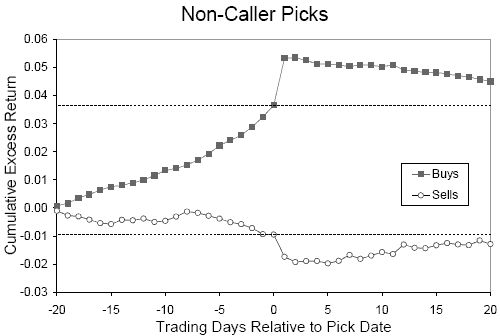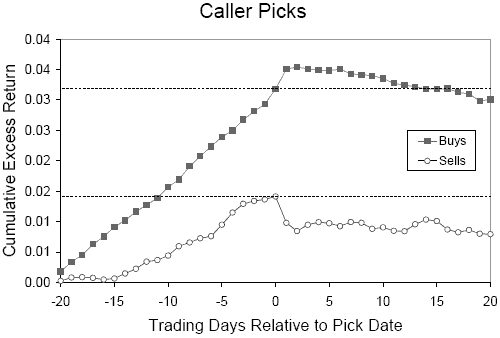Are Jim Cramer’s stock recommendations on CNBC’s Mad Money most meaningful for small-capitalization stocks, for which prices are most susceptible to influence by the concerted behavior of a group of individual investors? In their September 2007 working paper entitled “The Performance and Impact of Stock Picks Mentioned on Mad Money“, Bryan Lim and Joao Rosario evaluate the show’s ability to move markets over the short term and to forecast winners and losers over the long term. Using a sample of 10,589 Mad Money buy and sell recommendations representing 2,074 distinct firms, either initiated by Jim Cramer or provided by him in response to callers, from shows aired between June 28, 2005 and December 22, 2006, they conclude that:
- Jim Cramer’s stock-picking style is consistent with momentum investing, favoring stocks with recent relative strength.
- His immediate effect on a stock’s price tends to be inversely proportional to the firm’s market capitalization, consistent with a supposition that the effect results from viewers acting on his recommendations.
- Taking both abnormal volume and excess return into account, Jim Cramer’s effect on the next day after a recommendation is:
- Greater for Cramer-initiated recommendations than for caller-requested opinions.
- Greater for for buys than sells.
- Inversely proportional to market capitalization.
- The overnight change in price after a recommendation on average accounts for essentially all of the one-day return, so most traders cannot capture it.
- Over the short term (a few days), Cramer’s small-cap picks tend to outperform. His mid-cap and large-cap picks generally move in the predicted direction, but the returns are small. Because of an overnight gap down in price and subsequent short-term reversal, the best average returns come from buying Cramer-initiated small-cap sell recommendations. See the charts below.
- Over the long term (six months), Cramer’s small-cap stock picks are the most accurate, with buys (sells) on average trending upward (downward). However, mid-cap buys and sells on average both trend downward, and large-cap buys and sells on average are both about flat. Separately:
- Cramer-initiated recommendations move in the predicted direction, but average returns are within 1% of size benchmarks.
- Caller-requested buys and sells both have negative average excess returns, suggesting that callers tend to inquire about “hot” overvalued stocks.
The following chart, taken from the paper, shows average cumulative size-adjusted excess returns for Cramer-initiated (Non-Caller) picks from 20 trading days before to 20 trading days after broadcast. These buy (sell) recommendations have on average outperformed (underperformed) over the prior month. Next-day size-adjusted excess returns are 1.56% for buys and -0.88% for sells, after which slow partial reversals occur over the next month. Capturing next-day excess returns is problematic, because they essentially derive from opening gaps up or down.

The next two charts, also from the paper, show the cumulative size-adjusted excess returns for Cramer-initiated (Non-Caller) recommendations by market capitalization. Following a broadcast, the average next-day excess return for small-cap picks is large in magnitude, particularly for buys. The average excess return for small-cap buys is roughly flat after the first trading day, while that for sells drifts slightly downward for two weeks before sharply reversing. On average, purchasing small-cap sells at the next-day close yields a significantly higher one-month excess return than purchasing small-cap buys. The average excess return for mid-cap buys jumps the next trading day and then drift downward toward zero over the subsequent month. For mid-cap sells, the average next-day excess return appears to be part of a general downward drift from eight trading days before to eight trading days after the pick date. Large-cap stocks are largely unaffected by Cramer’s recommendations.

The next chart, also from the paper, shows average cumulative size-adjusted excess returns for caller-requested opinions from 20 trading days before to 20 trading days after broadcast. While both buys and sells exhibit increasing pre-broadcast returns on average, Cramer tends to recommend buying only the strongest outperformers. After small average next-day jumps up for buys and down for sells, both groups of recommendations tend to drift lower over the next month. Again, capturing next-day excess returns is problematic, because they essentially derive from opening gaps up or down.

The final two charts, also from the paper, show the cumulative size-adjusted excess returns for caller-requested recommendations by market capitalization. For all firm sizes, callers tend to ask about past outperformers. Small-cap buys continue their outperformance for about another week after broadcast before reversing and starting to drift downward. Small-cap sells begin a downward drift immediately after broadcast. Over the 20 trading days after broadcast, small-cap buys (sells) outperform (underperform). Mid-cap stocks exhibit on average small next-day jumps up for buys and down for calls, with both groups then drifting slightly downward. After 20 trading days, average post-pick excess returns are about the same for mid-cap buys and sells. Large cap stocks are generally unaffected by Cramer’s recommendations.

The authors caution that their simple buy-and-hold analyses do not precisely capture the nuances of Mr. Cramer’s recommended trading strategies.
In summary, Jim Cramer’s buy (sell) recommendations tend to gap up (down) overnight to a degree inverse to market capitalization and then level off or reverse over the next few weeks. In general, investors cannot capture the gaps. The best play for traders is to buy Cramer-initiated small-cap sell recommendations within a few days and wait for reversal over the next few weeks.
Results suggest that abnormal returns for Jim Cramer’s stock picks may be more a function of the influence of his audience on prices than of his ability to evaluate stocks.